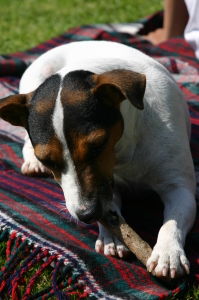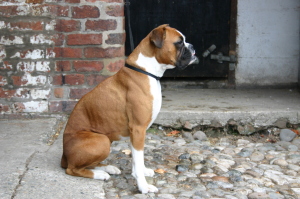New research suggests that the global exchange of frozen semen from dogs of registered breeds may be reducing genetic divergence between geographically distant dog populations. The study, published in Veterinary Record, looked at similarities between groups of dogs in South Africa and the UK.
According to rules set out by the Kennel Club in the UK (KCUK) and the Kennel Union of Southern Africa (KUSA), for a dog to be registered as a recognised breed, it must have five generations of ancestors of the same breed. Regulations such as this create a genetic barrier, limiting the number of genes that cross between breeds and reducing genetic diversity within breeds.
In a study published last year, Mellanby and others found that, in the UK, rottweilers, boxers and German shepherd dogs had the highest levels of inbreeding of the breeds studied. Labrador retrievers and border collies had lower levels of inbreeding (although genetic analysis showed that inbreeding was still present in these breeds). They also assessed a population of Jack Russell terriers, which are not recognised as a breed by KCUK, although they are by KUSA. Perhaps unsurprisingly, this non KCUK-registered population had the highest levels of genetic diversity in the study.

While each individual breed is genetically distinct, it was not known whether dogs of a particular breed in one country differed genetically from those in another. If boxer breeders in the UK tended only to breed from UK stock, it would be expected that this population would begin to genetically diverge from boxers in other countries. In other words, is a collie from Cape Town similar to one from Carlisle? Do the genes of a dobermann in Durban resemble those of one in Durham? These were some of the questions that an international team of researchers from institutions in the UK and South Africa sought to answer in a recent study published in Veterinary Record.
‘We had found that different dog breeds had different levels of genetic variation,’ says Kim Summers, one of the authors of the study. ‘We also knew that there were restrictions about importing animals into some countries, so we wanted to find out whether this meant that dogs of the same breed in two countries had started to diverge genetically’.
DNA material was obtained from German shepherd dogs, labrador retrievers and Jack Russell terriers that were brought to the University of Pretoria veterinary clinic in South Africa. The DNA was analysed and compared with that of DNA from UK dogs that had been analysed in a previous study.
The study yielded several interesting results. First, a coincidental finding was that many dogs thought to be purebred were actually of mixed breed origins. While these misclassified dogs had the physical traits of the breed they were classified as, in-depth genetic analysis showed that almost a third (four out of 14) of the South African labrador retrievers and one of 26 German shepherd dogs actually had mixed breed ancestry. Several of the South African dogs studied were also found to have had one parent from the registered breed and another that was a mixed breed
‘Most studies in the past have used only pedigree dogs registered with a breed association,’ said Prof Summers. ‘We were interested in how well the breed could be identified by looking at the dog, because correct identification of breed is important for knowing which genetic variants might be important in diseases the dog may have.’
Perhaps even more surprisingly, population analysis revealed that within each breed, dogs were remarkably similar regardless of the country.

‘We found that our genetic markers could not distinguish dogs of one breed based on their country of origin,’ Prof Summers explains. ‘So there was a genetic signature for labrador retrievers that was the same in South Africa as in the UK.’
The fact that dogs in the UK were found to be similar to dogs of the same breed half way across the world is puzzling. This would indicate that there is a reasonable amount of genetic admixture between dogs of the same breed. One way that this could occur, the authors suggest, is through the use of cryopreserved canine semen for artificial insemination. This has been available to dog breeders for some 50 years and it is now possible for semen to be frozen and transported long distances before being used in breeding. This worldwide exchange of genetic material could be preventing genetic isolation from occurring within breeds, despite vast geographical distances.
‘Breed associations and breeders are very concerned with the health of their breed’, said Prof Summers. ‘Encouraging the use of a wide range of sires and reducing matings between relatives will maximise genetic diversity and ensure that breeds are similar and healthy across the world.’